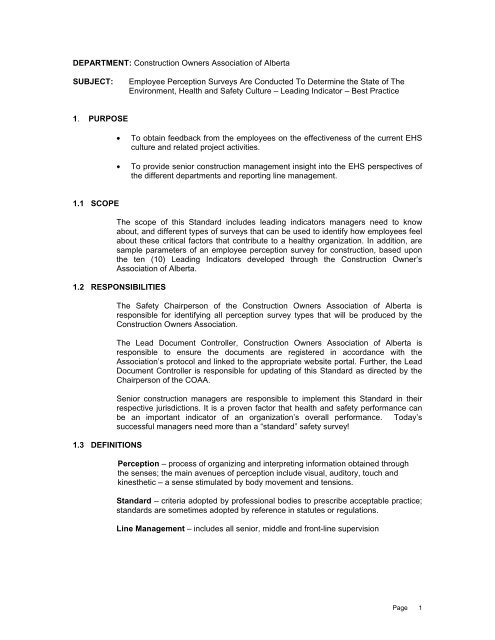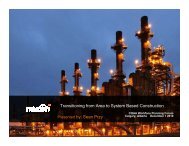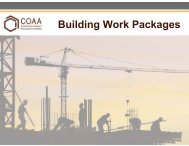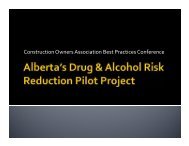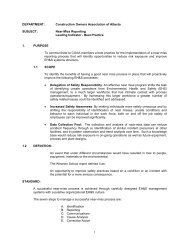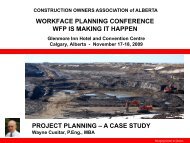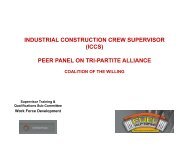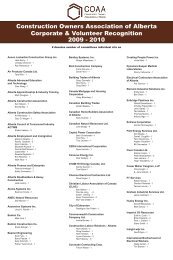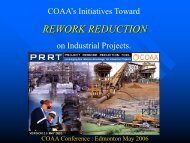Employee Perception Survey - Construction Owners Association of ...
Employee Perception Survey - Construction Owners Association of ...
Employee Perception Survey - Construction Owners Association of ...
You also want an ePaper? Increase the reach of your titles
YUMPU automatically turns print PDFs into web optimized ePapers that Google loves.
DEPARTMENT: <strong>Construction</strong> <strong>Owners</strong> <strong>Association</strong> <strong>of</strong> Alberta<br />
SUBJECT: <strong>Employee</strong> <strong>Perception</strong> <strong>Survey</strong>s Are Conducted To Determine the State <strong>of</strong> The<br />
Environment, Health and Safety Culture – Leading Indicator – Best Practice<br />
1. PURPOSE<br />
• To obtain feedback from the employees on the effectiveness <strong>of</strong> the current EHS<br />
culture and related project activities.<br />
• To provide senior construction management insight into the EHS perspectives <strong>of</strong><br />
the different departments and reporting line management.<br />
1.1 SCOPE<br />
The scope <strong>of</strong> this Standard includes leading indicators managers need to know<br />
about, and different types <strong>of</strong> surveys that can be used to identify how employees feel<br />
about these critical factors that contribute to a healthy organization. In addition, are<br />
sample parameters <strong>of</strong> an employee perception survey for construction, based upon<br />
the ten (10) Leading Indicators developed through the <strong>Construction</strong> Owner’s<br />
<strong>Association</strong> <strong>of</strong> Alberta.<br />
1.2 RESPONSIBILITIES<br />
1.3 DEFINITIONS<br />
The Safety Chairperson <strong>of</strong> the <strong>Construction</strong> <strong>Owners</strong> <strong>Association</strong> <strong>of</strong> Alberta is<br />
responsible for identifying all perception survey types that will be produced by the<br />
<strong>Construction</strong> <strong>Owners</strong> <strong>Association</strong>.<br />
The Lead Document Controller, <strong>Construction</strong> <strong>Owners</strong> <strong>Association</strong> <strong>of</strong> Alberta is<br />
responsible to ensure the documents are registered in accordance with the<br />
<strong>Association</strong>’s protocol and linked to the appropriate website portal. Further, the Lead<br />
Document Controller is responsible for updating <strong>of</strong> this Standard as directed by the<br />
Chairperson <strong>of</strong> the COAA.<br />
Senior construction managers are responsible to implement this Standard in their<br />
respective jurisdictions. It is a proven factor that health and safety performance can<br />
be an important indicator <strong>of</strong> an organization’s overall performance. Today’s<br />
successful managers need more than a “standard” safety survey!<br />
<strong>Perception</strong> – process <strong>of</strong> organizing and interpreting information obtained through<br />
the senses; the main avenues <strong>of</strong> perception include visual, auditory, touch and<br />
kinesthetic – a sense stimulated by body movement and tensions.<br />
Standard – criteria adopted by pr<strong>of</strong>essional bodies to prescribe acceptable practice;<br />
standards are sometimes adopted by reference in statutes or regulations.<br />
Line Management – includes all senior, middle and front-line supervision<br />
Page 1
2. STANDARD<br />
2.1 Critical factors to evaluate for a safe, healthy organization and a positive job<br />
climate.<br />
Senior construction management shall ensure the following leading indicators are<br />
evaluated within their employee perception survey:<br />
• Corporate Culture<br />
• Leadership and Planning<br />
• Communications<br />
• Hiring & Placement<br />
• Benefits<br />
• EHS, Quality, and Continuous Improvement<br />
• Career Development<br />
• <strong>Employee</strong> Role Definition<br />
• Your Immediate Supervisor<br />
• <strong>Employee</strong> Development Training<br />
• Respect/Treatment <strong>of</strong> <strong>Employee</strong>s<br />
• <strong>Employee</strong> Empowerment<br />
• Teamwork/Cooperation<br />
• Organizational and <strong>Employee</strong> Diligence<br />
• Physical Working Conditions<br />
• Stress/Workload<br />
• Satisfaction with the Job<br />
• Recognition/Rewards<br />
• Satisfaction with the Company<br />
• Job Security/Stability<br />
The perception survey questions shall be challenging, and created with the belief that all <strong>of</strong><br />
the above are significant contributing factors to the state <strong>of</strong> a safe and healthy organization.<br />
2.2 Example employee perception surveys that contribute to the state <strong>of</strong> the EHS culture.<br />
Senior construction management shall ensure that annually, creditable employee<br />
perception surveys are conducted that encompass the leading indicators <strong>of</strong> subsection 2.1<br />
above.<br />
2.2.1 Corporate Culture <strong>Survey</strong>s – a way to take the pulse <strong>of</strong> the organization - the vision<br />
<strong>of</strong> senior management <strong>of</strong> a culture they believe it takes to compete successfully in<br />
the competitive landscape. It is especially necessary to measure when there is<br />
suspicion the culture is out <strong>of</strong> sync with management’s desired culture, when<br />
management has determined the culture must be changed to ensure the success <strong>of</strong><br />
the enterprise, or when there has been a leadership change at the top <strong>of</strong> the<br />
organization.<br />
2.2.2 Productivity <strong>Survey</strong>s – anything that gets in the way <strong>of</strong> workers’ abilities to produce<br />
quality products and services efficiently must be carefully examined. The productivity<br />
survey identifies the barriers to productivity in place at an organization and will reveal<br />
the information required to tactically target the identified barriers impeding an<br />
organization.<br />
Page 2
Examples <strong>of</strong> barriers to productivity:<br />
• Improper training<br />
• Out <strong>of</strong> date tools and equipment<br />
• Overemphasis on centralized decision making<br />
• Politics causing different parts <strong>of</strong> the organization to pull in different directions<br />
• Incentives that reward maintenance <strong>of</strong> the status quo or unproductive employees<br />
as much as productive ones<br />
• Excessive risk aversion<br />
• Improper productivity measurement<br />
• Ignoring or not soliciting employee input<br />
2.2.3 Environment, Health & Safety (EHS) <strong>Survey</strong>s – typically, most organizations<br />
perform “standard” EHS surveys around the number <strong>of</strong> injuries/occupational illnesses<br />
due to accidents. This is a worthy goal but to the employees involved in the<br />
accidents, this measurement tool is reactive and <strong>of</strong> little solace. The modern day<br />
methodology for measurement is to proactively benchmark against the best, and<br />
score your company in percentages against the best!<br />
In addition to the above, evaluate the belief that injuries can be prevented, the priority<br />
people think others give to safety, the extent <strong>of</strong> safety training, the quality <strong>of</strong> the<br />
safety rules, the extent the safety rules are obeyed, to what extent disciplinary action<br />
is taken, to what extent injuries & incidents are reported, investigated, and followedup,<br />
and include subcontractors within the evaluation.<br />
To achieve and maintain safe operational excellence, the safe work plan<br />
management system must be implemented, managed, and measured as a<br />
continuous improvement cycle. The employee perception survey is the best indicator<br />
toward institutionalization.<br />
2.3 <strong>Employee</strong> perception survey parameters for construction, based upon the ten (10) leading<br />
indicators identified by the <strong>Construction</strong> <strong>Owners</strong> <strong>Association</strong> <strong>of</strong> Alberta (COAA)<br />
Senior construction management shall ensure that the COAA employee perception survey<br />
parameters <strong>of</strong> their ten (10) leading indicators are part <strong>of</strong> the execution plan for all projects.<br />
Project specific employee perception surveys can be created from the leading indicator<br />
parameters listed.<br />
2.3.1 Contractor selection (EHS) process is in place, prior to the start <strong>of</strong> a project.<br />
• Do all the contractors/subcontractors have WCB clearance?<br />
• Are all the contractors/subcontractors in a WCB discount percentage?<br />
• Have the contractors/subcontractors provided a client evaluation <strong>of</strong> their<br />
previous year contracts/projects?<br />
• Do the contractor/subcontractors employ full-time/part-time EHS<br />
pr<strong>of</strong>essionals -if so, have their current project resumes been approved<br />
• Have all the contractors/subcontractors had their EHS Manuals/Safe Work<br />
Plans approved?<br />
2.3.2 Hazard identification/analysis process in place, prior to the start <strong>of</strong> the<br />
project.<br />
• Has a collective risk review been conducted on the scope <strong>of</strong> work?<br />
Page 3
• Have the identified risk factors been assigned adequate controls or<br />
eliminated?<br />
• Have the potential loss exposures associated to the specific tasks been<br />
evaluated and controls/elimination been identified? (JHA’s)<br />
• Has the field level risk assessment process been established? (FLRA’s)<br />
• Is there an ongoing hazard/risk analyses process in place to pro-actively<br />
prevent similar undesirable events?<br />
2.3.3 Pre-hiring screening (Drugs & Alcohol).<br />
• Is pre-hire screening for D&A mandatory, pre-placement, random, for<br />
cause only, for sensitive positions, or not applicable?<br />
• Is there an established criteria/process for testing for any/all <strong>of</strong> the above,<br />
as applicable?<br />
• Does the project have the support <strong>of</strong> the worker representatives for any/all<br />
D&A applications?<br />
• Is the prime contractor applying the D&A principles <strong>of</strong> the Canadian Model<br />
with integrity?<br />
• Has an agreement/contract been established with a recognized D&A<br />
testing medical facility and applicable line management made aware <strong>of</strong> the<br />
protocol?<br />
2.3.4 Active management safety participation – tours, walkabouts,<br />
communications.<br />
• Has the Project line management team participated in a collective risk<br />
assessment <strong>of</strong> the scope <strong>of</strong> work?<br />
• Has the Project line management team participated in a Project kick-<strong>of</strong>f<br />
meeting with the client/prime contractor to clarify, verify, and receive<br />
approval for the Project execution plan, terms and conditions?<br />
• Does the Project line management participate in planned inspections,<br />
compliance observations, behavioral based observations, group<br />
communication/safety meetings, field level risk assessments, and<br />
recognition award presentations, as applicable?<br />
• Does the Project line management team provide leadership that promotes<br />
motivation and contributes to creating a positive job climate?<br />
• Does the Project have a structured loss control bulletin board where senior<br />
management communications are readily available to the employees?<br />
2.3.5 Supervisor’s safety activities are evaluated at regular intervals.<br />
• Are the supervisor’s safety qualifications adequate for the role?<br />
• Does the supervisor participate in the job hazard analysis process?<br />
• Does the supervisor participate in the field level risk assessments?<br />
• Does the supervisor chair the safety meetings and toolbox talks?<br />
• Does the supervisor coach, mentor, communicate, manage with integrity?<br />
2.3.6 Field level risk assessments (FLRA) are conducted prior to start <strong>of</strong> new<br />
work/at the beginning <strong>of</strong> shift.<br />
• Does the Project have approved FLRA assessment cards?<br />
• Have the general foremen, foremen and the workers been trained in the<br />
protocol for FLRA’s?<br />
• Are the FLRA’s being completed and used with integrity?<br />
• Who is the custodian <strong>of</strong> the FLRA’s at the end <strong>of</strong> the day?<br />
Page 4
3. IMPLEMENTATION<br />
• Is there an ongoing monitor measuring the integrity <strong>of</strong> the FLRA process?<br />
2.3.7 Near miss/near hit reporting process in place and working.<br />
• Does the Project have a system for near miss reporting?<br />
• Is it non-punitive?<br />
• Does immediate supervision encourage near miss reporting?<br />
• Who provides the feedback on near miss actions taken?<br />
• Are lessons learned from near misses communicated to the work force?<br />
2.3.8 Focus (compliance) observation process in place and working.<br />
• Is there a structured observation process set up for the Project?<br />
• Does the observation team consist <strong>of</strong> both management and workers?<br />
• Who does the record keeping for the observation tours?<br />
• Is the observation process being applied with integrity?<br />
• Are the results <strong>of</strong> the observation tours shared with the work force for<br />
lessons learned?<br />
2.3.9 Behavioral based observation process in place and working.<br />
• Is there a structured behavioral based observation process set up for the<br />
Project?<br />
• Does the observation team consist <strong>of</strong> both management and workers?<br />
• Have the observation team been formally trained?<br />
• Who does the record keeping for the observation tours?<br />
• Is the observation process being applied with integrity/lessons learned?<br />
• Are there recognition rewards for exemplary positive behavior?<br />
2.3.10 <strong>Employee</strong> perception surveys are conducted to determine the state <strong>of</strong> EHS<br />
health.<br />
• Does the employee perception survey incorporate any <strong>of</strong> the critical<br />
factors to evaluate for a safe, healthy organization and a positive job<br />
climate, as per subsection 2.1?<br />
• Is the employee perception survey based upon the parameters <strong>of</strong> the<br />
COAA ten (10) leading indicators for construction due diligence?<br />
• Is the employee perception survey being benchmarked against a current<br />
leader in a similar industry?<br />
• Will the findings <strong>of</strong> the employee perception survey be shared with all the<br />
stakeholders?<br />
• Will the stakeholders be a part <strong>of</strong> developing the path forward?<br />
Senior construction management <strong>of</strong> their respective companies shall ensure implementation <strong>of</strong><br />
this Standard within their areas <strong>of</strong> accountability.<br />
4. INTERPRETATION AND UPDATING<br />
The Safety Chairperson <strong>of</strong> the <strong>Construction</strong> <strong>Owners</strong> <strong>Association</strong> <strong>of</strong> Alberta shall ensure<br />
interpretation and updating <strong>of</strong> this Standard.<br />
Page 5
5. APPROVED BY<br />
Peter Dunfield<br />
Safety Chairperson<br />
<strong>Construction</strong> Safety <strong>Association</strong> <strong>of</strong> Alberta (COAA)<br />
Page 6


